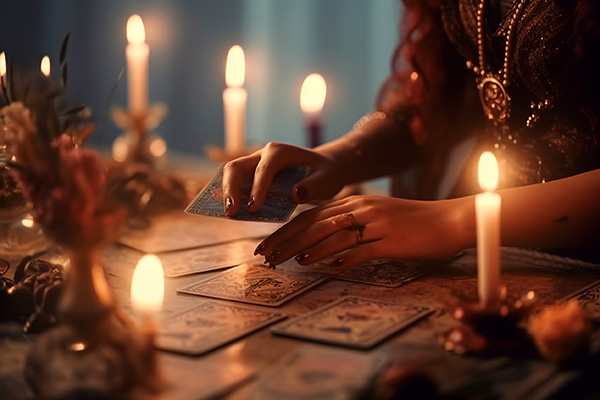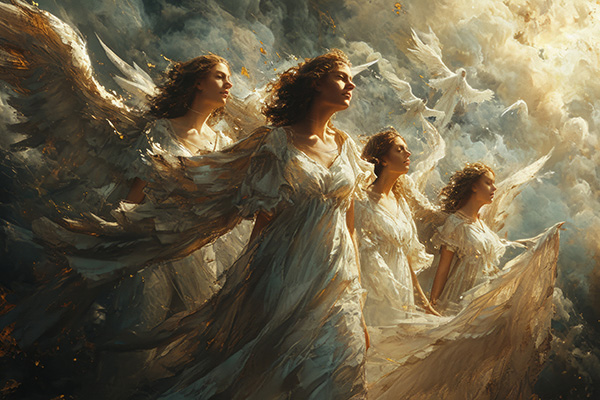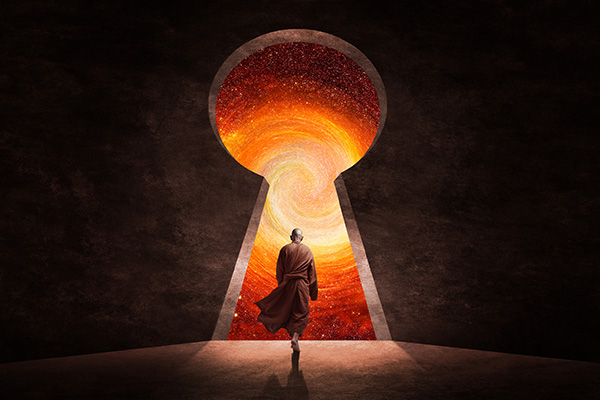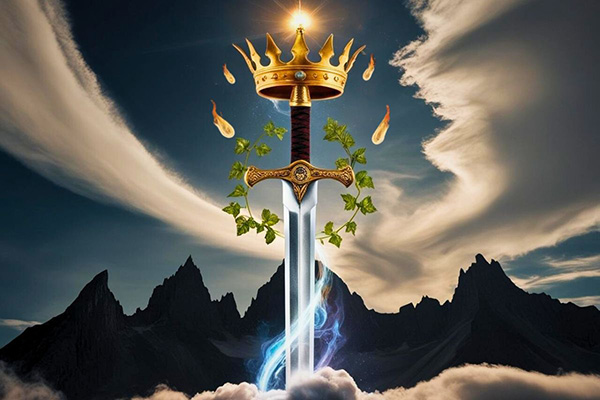How to Bring Forth Your Ultimate Life via Psychic Insights
 Manifestation is the practice of bringing your thoughts into the tangible world — a metaphysical journey that demands more than mere wishful thinking. It can only take place when your energy fully resonates with your aspirations.
Manifestation is the practice of bringing your thoughts into the tangible world — a metaphysical journey that demands more than mere wishful thinking. It can only take place when your energy fully resonates with your aspirations.
What if you encounter difficulties in realizing your dreams, regardless of the amount of visualization and affirmation you undertake? The solution often resides in hidden energetic obstacles or imbalances that obstruct the manifestation journey.
Psychic readings serve as a potent means to unveil these concealed hindrances, offering profound insights into your individual energy field and suggesting remedies to realign with your ultimate potential.
A common misconception is that if manifestations aren’t occurring, it simply indicates insufficient effort or unreachable desires. Yet, in numerous instances, the true challenge lies in energetic misalignment rather than a lack of determination.
Unresolved emotions, restrictive beliefs, karmic effects, and latent fears can generate blockages, preventing your aspirations from fully coming to fruition.
These concealed barriers can quietly interfere with your manifestation efforts, leading to frustration and stagnation no matter how hard you try.
Manifesting encompasses more than just positive thinking — it involves embodying the energy of your desires, eliminating resistance, and embracing a state of genuine receptivity.
Psychic readings can aid in identifying and clearing these blockages, enabling you to shift your energy and restore alignment with your highest self and true purpose. By connecting with your energy field, a talented psychic can expose underlying patterns, past traumas, or subconscious fears that may obstruct your manifestation capabilities.
You have the ability to transform your life, and it’s vital to recognize that. We often believe we are powerless, but that is not the case. We always possess the strength of our thoughts…embrace and actively wield your power ~ Louise Hay
Once these revelations surface, you can consciously take steps to heal and release them. Energy healing, meditation, and introspective work can further facilitate this transformation.
A psychic reading can assist in uncovering deeper issues related to manifestation by:
Recognizing vibrational misalignment: When your energy frequency isn’t synchronized with your true purpose or higher good, manifestation wavers, resulting in inconsistent outcomes. Desiring something from ego or societal pressure instead of authentic joy and fulfillment can create a metaphysical disconnect. A psychic reading can shed light on whether your intentions align with your soul’s highest good and propose adjustments to realign with your true path.
Identifying restrictive beliefs: Many of us harbor entrenched beliefs about money, love, success, or happiness that conflict with our manifestation efforts. Such beliefs often stem from childhood experiences, societal conditioning, or past disappointments, acting as invisible barriers to progress. A psychic reading can unveil these latent thought patterns, help you understand their origins, and guide you in shifting them for better energetic harmony.
Recognizing past life influences: Unresolved karmic obligations or detrimental past-life experiences can continue to shape our current circumstances in ways we may not recognize. Cycles of struggle, repeated failures, or irrational fears may arise from past-life experiences carried into this lifetime. A psychic reading can assist you in uncovering these karmic influences, liberating you from their hold on your present situation and breaking free from cycles that no longer serve you.
Revealing emotional blockages: Psychic readings can unveil repressed emotions that may distort your vibrational frequency and hinder manifestation. Unresolved grief, resentment, or fear can diminish your energetic vibration, complicating the attraction of positive outcomes. Healing these emotions through awareness, energy work, or guided assistance can restore balance and enhance your ability to manifest your wishes.
Uncovering a negative mindset: A pessimistic outlook or habitual negativity can create mental and emotional barriers that obstruct the manifestation process. If you frequently fixate on potential failures or linger on past disappointments, your energy might remain in a low vibrational state. Psychic guidance can aid in shifting your viewpoint and inspire you to cultivate a more positive and empowering perspective.
Clarifying intentions: Vague or unclear intention-setting often results in mixed or no outcomes in manifesting endeavors. When your vision is indistinct or inconsistent, the universe cannot align conditions to facilitate your manifestation. A psychic can help you refine and articulate your aspirations with greater specificity, empowering you to channel your energy with assuredness and purpose.
Addressing self-doubt and low self-worth: Believing you are undeserving or incapable of achieving your desires can undermine progress even before it begins. Negative self-talk, feelings of inadequacy, or a lack of self-worth construct invisible barriers that prevent you from fully claiming your power. Psychic insights can reveal these internal doubts and offer guidance to replace them with empowering beliefs.
Identifying inconsistent actions: While intention is crucial, sustained action is essential to bridge the gap between desire and actualization. Many individuals begin with fervor but lose momentum when immediate results are lacking. Anticipating immediate gratification and giving up too soon can hinder manifestation endeavors. A psychic reading can clarify whether your actions align with your intentions and propose ways to ensure continuous progress.
Identifying fears of failure or success: Anxiety over potential outcomes can lead to self-sabotaging actions that prevent you from seizing opportunities. Fear of failure can deter you from taking risks, while fear of success can stir anxiety about increased responsibilities or change. A psychic reading can assist you in identifying and conquering these fears, empowering you to embrace the full potential of your manifestations.
Identifying external distractions: Allowing daily stresses or distractions to dominate can dilute energetic clarity and weaken manifestation efforts. Life’s demands, toxic settings, or negative influences can divert your attention from aligning with your aspirations. A psychic reading can help spotlight these distractions and present strategies to maintain focus and safeguard your energy.
Unveiling hidden saboteurs: Sometimes people in our environment — consciously or subconsciously — can undermine our progress through negativity, jealousy, or manipulative behavior. These hidden saboteurs may instill doubts, drain energy, or subtly dissuade you from chasing your aspirations. A psychic can assist in identifying these negative influences, establish boundaries, and protect your energy from external disruption.
Highlighting a lack of gratitude: Concentrating solely on what’s lacking rather than valuing what you already possess can impede the manifestation process. Gratitude elevates your vibrational frequency and signals to the universe that you are ready to receive more blessings. A psychic can help you implement gratitude practices into your day-to-day life to enhance manifestation success.
By illuminating these concealed aspects, a psychic reading empowers you to take decisive action to align with your genuine desires. By addressing these energetic hurdles and making the required modifications, you can manifest your ideal existence with greater ease and flow.
The truth that everyone already knows intuitively is that we are all whole, complete, and perfect as we are, and that we can manifest whatever we choose by simply focusing on what we desire and letting go of everything else ~ Hale Dwoskin
Manifestation flourishes through a balance of belief, action, and openness. Reflecting on which of these factors resonate with your experience can aid you in recalibrating and moving toward your goals.
At Psychic Access, we recognize the significance of manifestation and the vital role energetic alignment plays in crafting the life of your dreams. Our psychic consultants are meticulously chosen from a diverse pool of exceptional talent to ensure you receive genuine, insightful, and ethical guidance.
We are devoted to delivering top-quality psychic insights and transformative readings to our clients around the globe. Our handpicked team of expert psychic consultants is here to assist you in gaining clarity, resolving energetic blockages and other manifestation challenges, and create the life you genuinely desire.
Our exceptional team at PsychicAccess.com shares their extensive psychic knowledge, expertise, and metaphysical insights to help you flourish in life. Whether you seek a deeper metaphysical understanding, validation of your experiences, or practical guidance for navigating life’s challenges, our expert psychic readers provide a safe and inspiring space for exploration and growth.
Manifesting your ideal life transcends merely positive thinking — it requires ensuring your energy is in complete alignment with your desires. If you’re struggling with manifestation, it may be time to delve into the deeper energetic dynamics shaping your reality.
A psychic reading can offer the clarity, healing, and guidance necessary to identify blockages, eliminate limiting beliefs, and realign with your highest vibration. With the expert insights from the gifted psychics at PsychicAccess.com, you can take charge of your manifestation.
|
Receive daily doses of psychic wisdom and spiritual inspiration from our talented advisors at PsychicAccess.com. We release new blog posts daily on our official blog site at PsychicBloggers.com. Each article is crafted for your enlightenment and personal growth by one of our skilled professional psychics. Our mission is to share our knowledge and insights, keeping you informed about the latest on psychic phenomena, divination, metaphysics, energy work, spiritual life design, the paranormal, and esoteric practices. If you are new to the Psychic Access wisdom community, your first reading with us is FREE with the psychic of your choice. Yes, we are that confident you will appreciate our services! Join us now at PsychicAccess.com. |
How to Bring Your Best Life into Existence Through Psychic Insights
Numerous individuals are fascinated by the prospect of creating their ideal life but often encounter difficulties in discovering effective methods to achieve this. While a variety of techniques exist, one increasingly popular approach is the use of psychic insights. Psychic revelations can offer invaluable guidance into our lives, unveiling hidden truths, identifying hurdles, and ultimately helping to manifest our desires. In this article, we will outline how to leverage the power of psychic insights to create your best life.
1. Grasping Psychic Revelations:
Psychic revelations are insights or data acquired through extrasensory perception (ESP) or enhanced intuition. Psychics have the talent to connect with the energy and vibrations of the universe, delivering guidance and revelations regarding various life facets. These insights can encompass personal reflections to predictions about what lies ahead.
2. Locating a Trustworthy Psychic:
To fully benefit from psychic insights, it is vital to find a reputable and reliable psychic. Ask for recommendations from friends or family who have experienced positive interactions with psychics. Additionally, consider reading reviews and testimonials to confirm that the psychic has a history of accurate readings. Remember, a credible psychic will always prioritize your well-being and provide guidance grounded in integrity.
3. Defining Clear Intentions:
Before consulting a psychic, it’s imperative to set clear intentions regarding what you hope to achieve. Spend some time reflecting on the areas of your life where you desire improvement, such as relationships, career, or personal development. By clarifying these intentions, you offer the psychic a cohesive direction, allowing them to provide pertinent and accurate insights.
4. Actively Engaging in the Reading:
During a psychic reading, it’s crucial to actively engage and participate with the psychic. Stay open-minded and receptive to the information presented, even if it challenges your current beliefs or expectations. Pose questions, seek clarification, and give feedback to foster a meaningful and insightful session. The more you engage, the more you can gain from the psychic insights.
5. Incorporating Psychic Insights into Your Life:
Once you receive psychic insights, it’s essential to weave them into your daily existence. Take time to contemplate the insights gathered and recognize any changes or actions that may be necessary. Psychic revelations can act as a guide for manifesting your best life, but it is up to you to enact the necessary steps for their realization. Embrace the guidance provided and make deliberate choices that align with your expanded awareness.
6. Trusting the Journey:
Creating your best life through psychic insights necessitates trust in the journey. Acknowledge that the revelations may not always correspond with your immediate desires or expectations. Trust that the universe has a plan for you, and that the psychic insights are intended to guide you toward your ultimate good. Patience, determination, and an open mind are critical for successfully manifesting your ideal life.
In conclusion, psychic insights can represent a formidable resource in your pursuit of an ideal existence. By finding a dependable psychic, defining clear intentions, actively engaging in sessions, integrating insights into your life, and trusting the overall process, you can access valuable guidance and understanding. Remember, psychic revelations are not a magical solution; rather, they are tools that assist you on your journey toward manifesting your desires. Embrace the influence of psychic insights and take proactive measures towards creating the life you genuinely seek. Continue reading

















